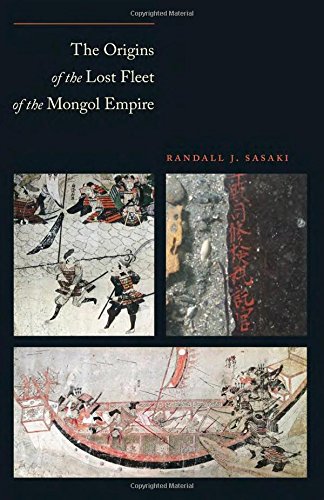Join us for a free one-day workshop for educators at the Japanese American National Museum, hosted by the USC U.S.-China Institute and the National Consortium for Teaching about Asia. This workshop will include a guided tour of the beloved exhibition Common Ground: The Heart of Community, slated to close permanently in January 2025. Following the tour, learn strategies for engaging students in the primary source artifacts, images, and documents found in JANM’s vast collection and discover classroom-ready resources to support teaching and learning about the Japanese American experience.
Sasaki, The Origins of the Lost Fleet of the Mongol Empire, 2014
Randall J. Sasaki. The Origins of the Lost Fleet of the Mongol Empire. Ed Rachal Foundation Nautical Archaeology Series. College Station Texas A&M University Press, 2014. Illustrations. 216 pp. $50.00 (cloth), ISBN 978-1-62349-194-9.
Reviewed by Sila Tripati (CSIR National Institute of Oceanography)
Mongol Maritime Efforts

In 1281, under the rule of Khubilai Khan, the Mongols sent a fleet of more than four thousand vessels to subjugate the island nation of Japan. A powerful typhoon, ever since mythologized by the Japanese as kamikaze or "divine wind," struck the invading fleet, leaving it in pieces on the shores of Japan. In his pathbreaking work, researcher Randall J. Sasaki has dug through hundreds of timbers salvaged from wrecks at the Takashima underwater site. It is not often that someone takes on the arduous task of sifting through pieces of timber that hold clues to sea battles seven centuries ago. Sasaki takes on what some would argue is the most technical and precise of tasks one would expect of a marine archaeologist. If discovering history, and specifically maritime history, is your first love, this book is a good guide for you to follow.
Sasaki sets the stage through a bold claim in the preface: "The book ... is about the detailed account of the discovery and analysis of the actual remains of timbers from the shipwrecks found beneath the waves. As you will read, in the hands of a trained archaeologist the physical remains of the vessels can reveal a story" (p. x). His goal is "to reveal the naval organization of the second Mongol invasion of Japan" by determining "what kinds of ships were brought to Japan, where they were built, how the ships were constructed and what strategy was behind the invasion plan" (pp. xi-xii). Japanese underwater archaeologists began to uncover pieces of artifacts and remains of hulls from the island of Takashima beginning in the early 1980s. Sasaki takes readers through a detailed analysis of the more than five hundred timber fragments, which were recovered from the wreck, most of which were "in poor condition," which, he says, made analysis difficult. Sasaki has painstakingly analyzed the timber for species of tree; the joinery of the timbers, both non-iron nail and iron nail; the artifacts found at the site, which he says were few, because this was primarily a military expedition; and the naval organization of the voyage. Separate chapters are dedicated to each issue.
Sasaki finds that "many of the timbers belonged to small vessels most likely from the Yangtze River area," suggesting that it was more of the smaller Yangtze Valley rounded-hull vessels that met their waterloo in the typhoon as they were less seaworthy (p. 144). "The fleets that Khubilai Khan dispatched to Japan were divided into functions and well organized. The Eastern Army used flat-bottom vessels built in Korea as landing craft to attack the Japanese forces and gain initial control of a small piece of territory on mainland Japan. The Southern Army's fleet consisted of V-shaped cargo ships built in Fujian Province for carrying provisions as well as rounded-hull and flat-bottom vessels made along the Yangtze River and functioning as reconnaissance and miscellaneous craft. The smaller vessels supported and protected the large supply ships. Khubilai and his advisors seem to have studied the natural resources, people, and ships of the mainland areas he had subjugated and then used them to attack another land," Sasaki notes in his conclusions (p. 142). He also states that "no timber can be confirmed to have derived from a Korean vessel" based on the study of either the timber or the joinery and that it concurred with historical documents and other artifacts found at the wreck site in Takashima (p. 145). Adverting to the debate around the reasons for the expedition's failure, Sasaki writes: "The ships that sank were not all poorly built or were crushed because they were riverboats. Some were strongly built and some were repaired, but having been repaired should not be taken as evidence for weak ships" (p. 146).
Sasaki, however, knows the limits of his study. "Why did the fleet fail in its purpose? Although these questions are intriguing, the aim of my research was to identify the origins and types of vessels used for the second invasion. Further study, both with the archaeological record and with historical documents, with particular attention to such questions is required," he observes (p. 145).
Featured Articles
Please join us for the Grad Mixer! Hosted by USC Annenberg Office of International Affairs, Enjoy food, drink and conversation with fellow students across USC Annenberg. Graduate students from any field are welcome to join, so it is a great opportunity to meet fellow students with IR/foreign policy-related research topics and interests.
RSVP link: https://forms.gle/1zer188RE9dCS6Ho6
Events
Hosted by USC Annenberg Office of International Affairs, enjoy food, drink and conversation with fellow international students.
Join us for an in-person conversation on Thursday, November 7th at 4pm with author David M. Lampton as he discusses his new book, Living U.S.-China Relations: From Cold War to Cold War. The book examines the history of U.S.-China relations across eight U.S. presidential administrations.




